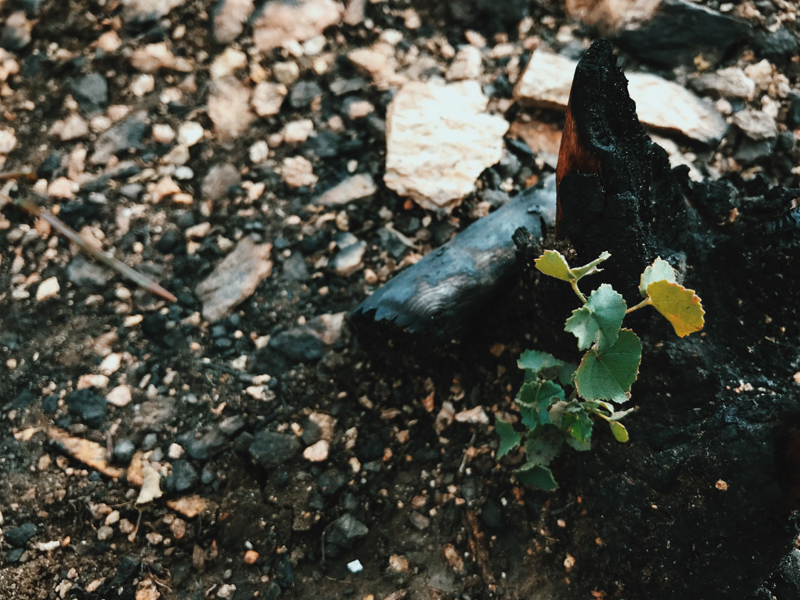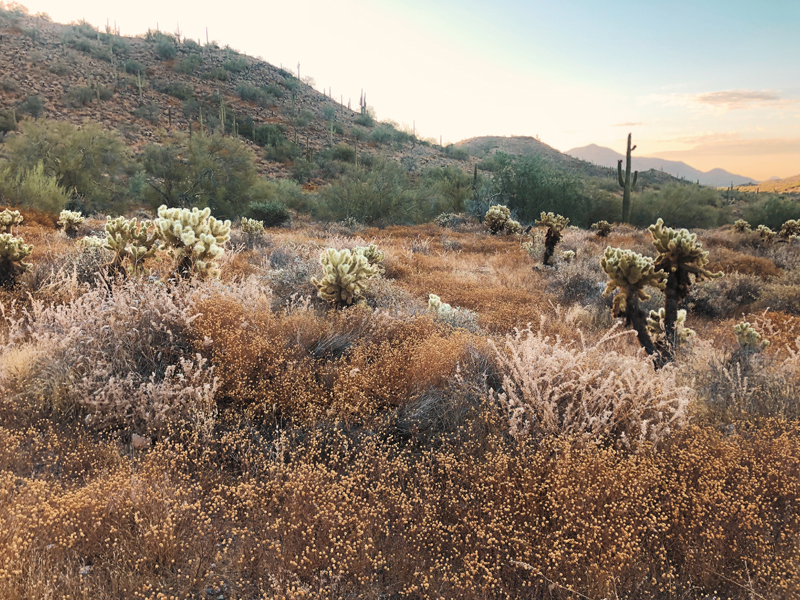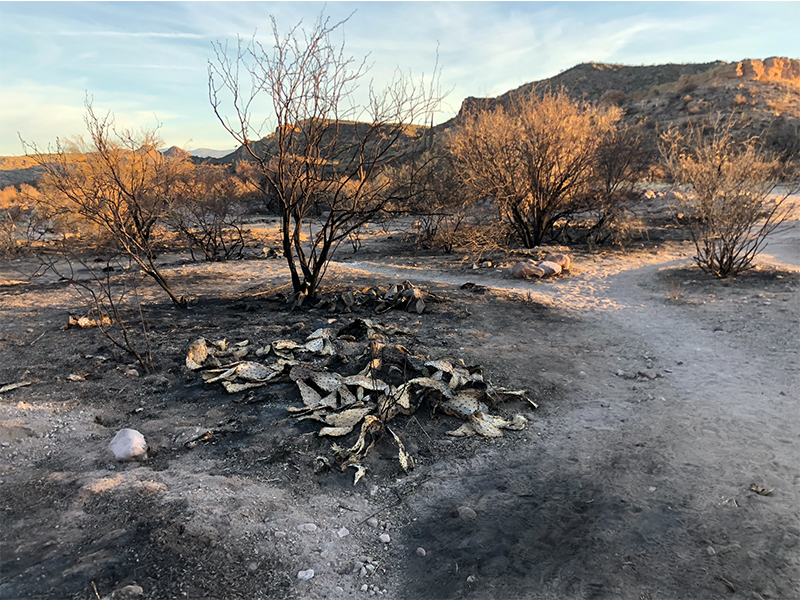Week 4 | Restoration
The Sonoran Desert expands from Central Arizona south into the Mexican state of Sonora and the Peninsula of Baja California. This beautiful region of the world is at risk from increasingly intense and frequent wildfires, a worsening drought and other factors like climate change. Restoration of this unique desert region and the understanding of best restoration practices is incredibly important.
Restoration or ecological restoration can be defined as the process of assisting the recovery of an ecosystem that has been degraded, damaged or destroyed. There is still much researchers and land managers have yet to understand about restoration of the Sonoran Desert, including post-wildfire recovery.
Fires in the Sonoran and Mojave deserts were historically infrequent. When fires did occur, gaps in the vegetation between the different cactus, trees and other native shrubs, limited the spread of fires. However, since the 70s, nonnative plants and grasses have invaded the desert and become increasingly dominant in both natural areas and lands adjacent to them. Additionally many times, invasive plants recover faster, re-sprouting vigorously post-fire and dominating a landscape early on, diminishing chances of native biodiversity recovering even more.
These increasing fuel loads, growing human populations, and other disturbances in the arid Southwest have led to more fires, which threaten native plants and wildlife that are poorly adapted to survive their increasing frequency and intensity. Desert areas disturbed by wildfires or any other type of disturbance, whether that be grazing or roadbuilding, may take many decades or centuries to recover without active intervention.
For municipal parks and preserves, post-wildfire work is critically important, especially in ensuring the safety of both the public and the natural resources. Restoration of impacted areas can be costly and require a large investment of time from park staff. Trails can be highly impacted by fire, for example, and soil erosion is atop concern. Rains after a fire can wash away that top layer of ash, dirt and material and with nothing to stop its path, parks can undergo much damage.
Revegetation and restoration requires careful attention to ecological relationships, both above and below ground, wildlife interactions, soil characteristics, microclimate and patterns of precipitation. In the desert, undoing the damage done to the soil system is a critical step toward recovery. There are organizations like McDowell Sonoran Conservancy that are working to study these important soils. Restoration after wildfire isn’t as simple as throwing seed onto a burned area. Native seed supply is low, and determining which species to plant where takes careful consideration. Young plants that may grow will need supplemental water with continued drought and some protection from hungry wildlife. Managing restoration in an area as large as the Bush Fire footprint is no small task.
It’s important to remember that it isn’t all doom and gloom. There are many ways concerned and interested people can contribute. Becoming a volunteer with local organizations helpingremove invasive plants, planting natives in your yardor becoming community scientists are someways to contribute to the recovery and preservation of this amazing region.
What are ways you can support restoration in the Sonoran Desert?
- Plant Native. Your yard, patio or balcony matters! Even small patches of plants can supply food for native insects and create habitat for birds and other wildlife. You can make a difference, especially near areas that have been impacted by wildfire. Learn more: aznps.com/grow-native/
- Respect burned areas while they recover. Closures are put in place for the safety of recreationalists and for the health of the land. They can prevent injuries from unstable soil and collapsing vegetation, as well as give small seedlings a chance to grow and not be crushed. Latest closure info: dffm.az.gov/fire-restrictions-and-closures-across-arizona
- Community (citizen) science. Join programs like the Metro Phoenix EcoFlora and contribute valuable information to land managers and organizations. dbg.org/partner-initiatives/ecoflora/
- Join the Desert Defenders program to map and remove invasive plants: cazca.org/project/desert-defenders
- Support the development of native seeds! Check out your local seed libraries, or grow your own and donate them.
- Volunteer and get to know more of the great conservation organizations in Central Arizona:cazca.org/about-us/partners/
Week 3 | Invasive Species
The beautiful desert landscape of Arizona is a main reason people travel to and choose to live in Arizona. An overwhelming 92% of Arizonans strongly support the protection of the natural areas that surround them, according to a 2020 Gallup poll. The Greater Phoenix area and a good portion of the state are part of the Sonoran Desert, a unique and vibrant region of the U.S. that is increasingly at risk.
One of the most biodiverse deserts in the world, the Sonoran Desert is home to wildlife like javelina, coyotes and gila monsters, and to plants like the legendary saguaro, ocotillo and organ pipe cactus. Native plants, even when covering the desert floor in the height of spring, provide very little fuel to carry and sustain fire, so when one does occur, like in the case of a lightening strike, large wildfires are unlikely. For this reason, the large-scale wildfires we have seen here in the last 20 years are not thought to be part of the natural history of the region.
Over time, humans have altered the natural landscape with the introduction of nonnative species. Some of these nonnative species have become “invasive” or noxious. Invasive species are defined as those whose introduction causes or is likely to cause economic or environmental harm, or harm to human health. This introduction of invasive plants—by humans or commerce— ave slowly changed the desert. They are among the biggest threats to healthy ecosystems because they often crowd out native plants and decrease biodiversity, which can have significant detrimental effects on the natural food chain.
The relationship between invasive plants and wildfire cannot be ignored. As invasive plants spread further and grow denser, the wildfire risk increases. More recently, successive wet winters combined with hotter, drier summers have contributed to an increase of dried vegetation, creating a perfect storm of biomass fuel for wildfires. Many of these species are invasive grasses, including fountain grass (Pennisetum setaceum), buffelgrass (Cenchrus ciliaris), red brome (Bromus rubens), Mediterranean grass (Schismus barbatus) and stinknet (Oncosiphon pilulifer). These plants can dominate the desert landscape and are filling the open space that historically existed between desert plants. Now, when a fire starts in the Sonoran Desert, instead of burning a small patch of vegetation and then burning out, the fire can “run” because all of these plant patches are interwoven in a fabric of invasive species and increased annual vegetation growth. The result is larger wildfires, among other major impacts.
Managing this challenge can be difficult and requires the collaborative work of many agencies and organizations. The Central Arizona Conservation Alliance (CAZCA) and partnering organizations are working to take action against invasive species through the Desert Defenders. Desert Defenders is a community science program focused on finding, mapping and removing invasive species at local parks and preserves. The plant species that we focus on are known to have a moderate to severe impact on local ecosystems, and a few pose a risk for our community by raising the fire risk and even worsening seasonal allergies. The data collected through the tireless work of our Defenders is crucial for park staff and land managers to protect the desert parks we all love.
How can you help prevent wildfires?
- Practice early detection with us! It’s important to remove and manage harmful weeds in a timely manner. Participate in a removal event at a park or preserve or remove these harmful plants from your yard.
- Plant native! Recognizing the value and importance of native plants in our yards and communities is the first step. Ask for native plants at your local nurseries. You can also help by participating in any of the efforts against invasive plants.
- Join the Desert Defenders program or a partnering organization to help map, remove and monitor invasive plants in our parks and preserves.
- Explore and learn more about the National Fire Protection Association’s Firewise USA™ program which teaches homeowners simple things you can do to reduce the risk of your property from wildfire.
Week 2 | Impact
Over time, and especially in recent years, fires have been occurring more often, burning hotter and burning much larger areas, creating megafires. This has significant impacts for a desert ecosystem not adapted to co-exist with these frequent wildfires and for the people living in it.
Immediately impacted due to the start of a fire is air quality. Fires create large increases in outdoor airborne particles and pollutants. Indoor air quality is also affected, because many living spaces are not equipped, or poorly equipped, to filter the pollution. Larger fires can increase air pollution over hundreds of square miles, leading to various health impacts, specifically respiratory, for a greater number of people. Wildfires also have a major impact on our water, not only immediately after, but for years following. Vegetation that normally holds soil together is burned away, and ash, sediment and contaminants (such as those from mining operations or burned homes) are washed into waterways and reservoirs by rain, impacting our drinking water. The loss of vegetation in burned areas leads to erosion and increases an already significant risk in the desert: flash flooding.
Wildfire directly impacts public lands, recreation and tourism. The initial impact on public lands are closures. Closures are put in place for the safety of recreationalists and for the health of the land. They can prevent injuries from unstable soil and collapsing vegetation, as well as give small seedlings a chance to grow and not be crushed. The efforts to restore burned areas, like trail maintenance and revegetation can be a major economic burden, especially for smaller municipalities. Adding to the burden, the fire impacted areas can take decades to recover and are less desirable for recreation and tourism during that time.
With the frequency and size of fires increasing, the effects on habitat can be severe. Large areas of habitat are being lost closer in time. In a matter of two years (2019-2020), about 350,000 acres have burned adjacent to each other in the Superstition Wilderness and the Tonto National Forest. To put this in perspective, that’s an area roughly the size of Phoenix. In total, about 1 million acres in Arizona were burned in 2020, an area slightly smaller than the state of Delaware. Megafires also impact wildlife, including larger mammals that can normally survive smaller fires. In the desert, reptiles that in the past could have survived smaller, more patchy fires are now likely unable to escape. Increasing frequency of fire can also mean repeat burning of the same areas, giving desert habitat less time to recover- an already slow process.
The impacts of wildfire are far-reaching, including the often less thought of, such as insurance costs and the toll on mental health. We can all do our part to prevent wildfires from happening in the Sonoran Desert.
For more information:
Plants that are fire adapted have traits to help them survive, recover or reproduce after wildfire. Examples of this include seeds that rely on heat from fire to help them germinate, thick bark that protects a tree from fire damage, or plants that can resprout from their roots after the top part of the plant has burned away. Having evolved complex heat and drought resistant features, but no real resistance to fire or an ability to survive it, points to the absence of fire in the life of plants in the Sonoran Desert. Many of these desert plants also have very specific conditions for seeds to germinate and growth is often painfully slow. This not only suggests that fire is not a normal part of their life cycle, but also that recovery after fire can be challenging.
Cactus and succulents are almost always killed outright by fire, especially low growing species like fishhook cactus (Mammillaria grahamii) and hedgehog cactus (Echinocereus spp.). Saguaros (Carnegiea gigantea), if they are not initially killed by fire, most often succumb to moderate or severe fire injury within the next decade or sooner. A study from the Tonto National Forest shows that saguaros scorched just 30% or more are likely to not recover. Saguaro seedlings and young plants are lost. It can take a decade for these icons to reach one inch in height, 50 to 60 years to reach about 6 feet, and 90 to 100 years to reach about 15 feet. It could take multiple human generations after a fire for saguaros to regain the widespread majesty of a forest, if they can. Some agaves, such as Parry’s agave (Agave parryi), may be able to survive lower intensity fire if they’ve produced several “pups” (clonal ramets) from their underground stems – the stems within that clone may survive if the low intensity fire doesn’t burn the entire clone.
Brittlebush (Encelia farinosa) and triangle-leaf bursage (Ambrosia deltoidea) are most often reduced to ash, eventually making a comeback thanks to seed from other areas. They are considered “nurse plants,” and create favorable conditions for other plants to be able to move back in and grow. Foothills palo verde (Parkinsonia microphylla) and ocotillo (Foquieria splendens) can be completely eliminated by fire and have been reported to not return in some burned areas. Even a fire that is considered low or medium intensity can be detrimental for palo verde, scorching their thin bark that they use for photosynthesis. Although plants like jojoba (Simmondsia chinensis) or creosote (Larrea tridentata) can resprout, it is not guaranteed. The plants that seem to handle fire the best and resprout vigorously, such as fairy duster (Calliandra eriophylla) and catclaw (Senegalia greggii), are often those that are also found outside of the Sonoran Desert in areas that are fire adapted.
It is important to remember that even if plants seem to have survived fire, or do not look badly damaged, they are likely to be less healthy and not live as long as they normally would. Plants that have been damaged are weakened and disease can more easily move in. Severely damaged plants can be taken down by wind, and plants that have sprouted new growth are a tasty snack for hungry wildlife looking for food after fire. Overall, wildfire has detrimental effects on Sonoran Desert plants.
Week 1 | Prevention
Fire-adapted ecosystems are those that experience a regular occurrence of fire, mostly to the benefit of the ecosystem. To the best of our knowledge, natural fires have not historically been a significant part of the Sonoran Desert. Unlike fire-adapted ecosystems, most of the plant and animal life in the desert is not built to withstand fire. Compounding factors such as climate change, invasive species, and a rise in outdoor recreation have contributed to an increase in major fires here in the Sonoran Desert. These larger, and often hotter fires are happening closer together in time, and do not play well with a desert that is not adapted for it. It’s estimated that the Sonoran Desert could take more than 65 years to recover after fire, and iconic species like the saguaro may not return to the burned area. Sonoran Desert that has been severely impacted by or has experienced repeated incidence of fire has the potential to shift to a very different landscape than what we know now.
In 2020, 82% of wildfires in Arizona were caused by people, making it the leading cause of wildfire in the state. Seven out of ten of the largest fires in Arizona’s history were human caused, including the recent Bush Fire in 2020 and the Woodbury Fire in 2019. The Woodbury fire alone devastated about 75% of the Superstition Wilderness. With environmental conditions increasingly favoring fire, it’s more important than ever to do our part to keep them from starting.
How can you help prevent wildfires?
EVERY SECOND COUNTS! If you see something say something. Report wildfires as soon as possible. Do not assume it has already been reported. Call 911 or 800.309.7081 for the Arizona Interagency Dispatch for wildland fires and risk incidents. Click here to learn more about reporting wildfires.
- Outdoor Recreation: Know before you go! Take the time to understand fire regulations. These are not in place to keep you from having fun, but to keep us all safe. Learn how to properly build and extinguish campfires, and never leave a fire unattended. Avoid creating bonfires. Larger fires are more difficult to manage and embers can travel for miles. Both fireworks and explosives are illegal on public lands. You can also volunteer to remove invasive plants from natural areas, which contribute to fire intensity and spread.
- Vehicle/Off-Road: Do not drive in or park on dry grass or brush. Your car is hot enough to start a fire! Check your chains, these can spark and start a fire. According to the US Forest Service, over 30 small fires were known to have started this way, with one chain lighting sparks as it went down the road. Conduct pre-ride inspections, especially to clean out weeds and other debris from around the engine and other hot components. Keep a shovel, extra water and a fire extinguisher in your vehicle and learn how to use them effectively. Do not throw lit cigarettes or butts out the window.
- Shooting: Shoot targets in areas free of dry vegetation, such as dirt or gravel, and do not shoot on hot, windy days. Use appropriate ammunition and targets. Solid copper and steel core ammunition are most likely to start a fire, whereas lead core bullets are the least likely. Incendiary or tracer ammunition should be avoided in areas prone to fire. Shooting at steel targets or rocks can cause sparks–explosive targets should not be used. Have a shovel and fire extinguisher ready.
We can all do our part to prevent wildfires and keep the desert safe for ourselves and future generations to appreciate and enjoy.
Learn more at the resources below:
https://wildlandfire.az.gov/prevention-news



























